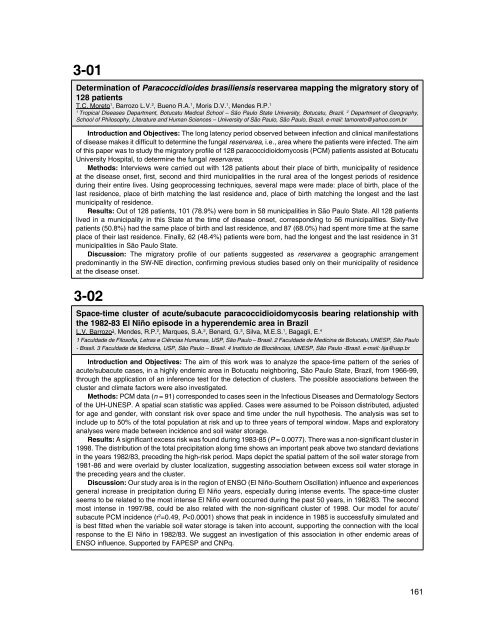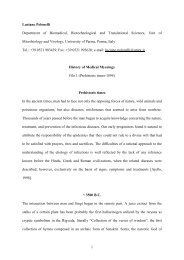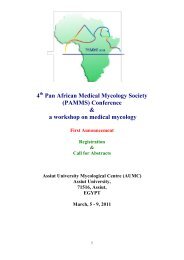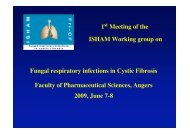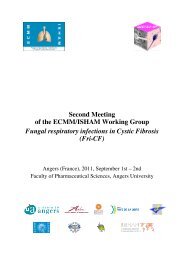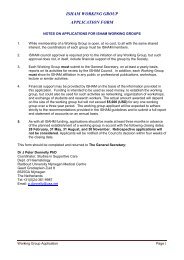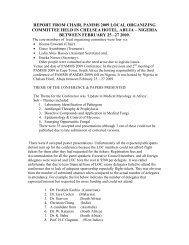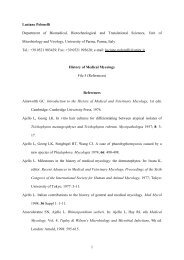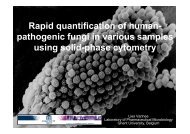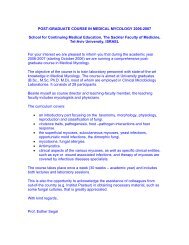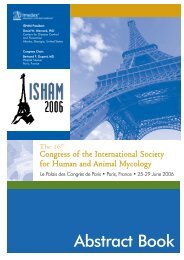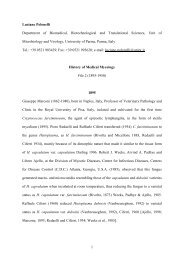Memoria CD.indd - ISHAM
Memoria CD.indd - ISHAM
Memoria CD.indd - ISHAM
Create successful ePaper yourself
Turn your PDF publications into a flip-book with our unique Google optimized e-Paper software.
3-01Determination of Paracoccidioides brasiliensis reservarea mapping the migratory story of128 patientsT.C. Moreto 1 , Barrozo L.V. 2 , Bueno R.A. 1 , Moris D.V. 1 , Mendes R.P. 11Tropical Diseases Department, Botucatu Medical School – São Paulo State University, Botucatu, Brazil. 2 Department of Geography,School of Philosophy, Literature and Human Sciences – University of São Paulo, São Paulo, Brazil. e-mail: tamoreto@yahoo.com.brIntroduction and Objectives: The long latency period observed between infection and clinical manifestationsof disease makes it difficult to determine the fungal reservarea, i.e., area where the patients were infected. The aimof this paper was to study the migratory profile of 128 paracoccidioidomycosis (PCM) patients assisted at BotucatuUniversity Hospital, to determine the fungal reservarea.Methods: Interviews were carried out with 128 patients about their place of birth, municipality of residenceat the disease onset, first, second and third municipalities in the rural area of the longest periods of residenceduring their entire lives. Using geoprocessing techniques, several maps were made: place of birth, place of thelast residence, place of birth matching the last residence and, place of birth matching the longest and the lastmunicipality of residence.Results: Out of 128 patients, 101 (78.9%) were born in 58 municipalities in São Paulo State. All 128 patientslived in a municipality in this State at the time of disease onset, corresponding to 56 municipalities. Sixty-fivepatients (50.8%) had the same place of birth and last residence, and 87 (68.0%) had spent more time at the sameplace of their last residence. Finally, 62 (48.4%) patients were born, had the longest and the last residence in 31municipalities in São Paulo State.Discussion: The migratory profile of our patients suggested as reservarea a geographic arrangementpredominantly in the SW-NE direction, confirming previous studies based only on their municipality of residenceat the disease onset.3-02Space-time cluster of acute/subacute paracoccidioidomycosis bearing relationship withthe 1982-83 El Niño episode in a hyperendemic area in BrazilL.V. Barrozo 1 , Mendes, R.P. 2 , Marques, S.A. 2 , Benard, G. 3 , Silva, M.E.S. 1 , Bagagli, E. 41 Faculdade de Filosofia, Letras e Ciências Humanas, USP, São Paulo – Brasil. 2 Faculdade de Medicina de Botucatu, UNESP, São Paulo- Brasil. 3 Faculdade de Medicina, USP, São Paulo – Brasil. 4 Instituto de Biociências, UNESP, São Paulo -Brasil. e-mail: lija@usp.brIntroduction and Objectives: The aim of this work was to analyze the space-time pattern of the series ofacute/subacute cases, in a highly endemic area in Botucatu neighboring, São Paulo State, Brazil, from 1966-99,through the application of an inference test for the detection of clusters. The possible associations between thecluster and climate factors were also investigated.Methods: PCM data (n = 91) corresponded to cases seen in the Infectious Diseases and Dermatology Sectorsof the UH-UNESP. A spatial scan statistic was applied. Cases were assumed to be Poisson distributed, adjustedfor age and gender, with constant risk over space and time under the null hypothesis. The analysis was set toinclude up to 50% of the total population at risk and up to three years of temporal window. Maps and exploratoryanalyses were made between incidence and soil water storage.Results: A significant excess risk was found during 1983-85 (P = 0.0077). There was a non-significant cluster in1998. The distribution of the total precipitation along time shows an important peak above two standard deviationsin the years 1982/83, preceding the high-risk period. Maps depict the spatial pattern of the soil water storage from1981-86 and were overlaid by cluster localization, suggesting association between excess soil water storage inthe preceding years and the cluster.Discussion: Our study area is in the region of ENSO (El Niño-Southern Oscillation) influence and experiencesgeneral increase in precipitation during El Niño years, especially during intense events. The space-time clusterseems to be related to the most intense El Niño event occurred during the past 50 years, in 1982/83. The secondmost intense in 1997/98, could be also related with the non-significant cluster of 1998. Our model for acute/subacute PCM incidence (r 2 =0.49, P


